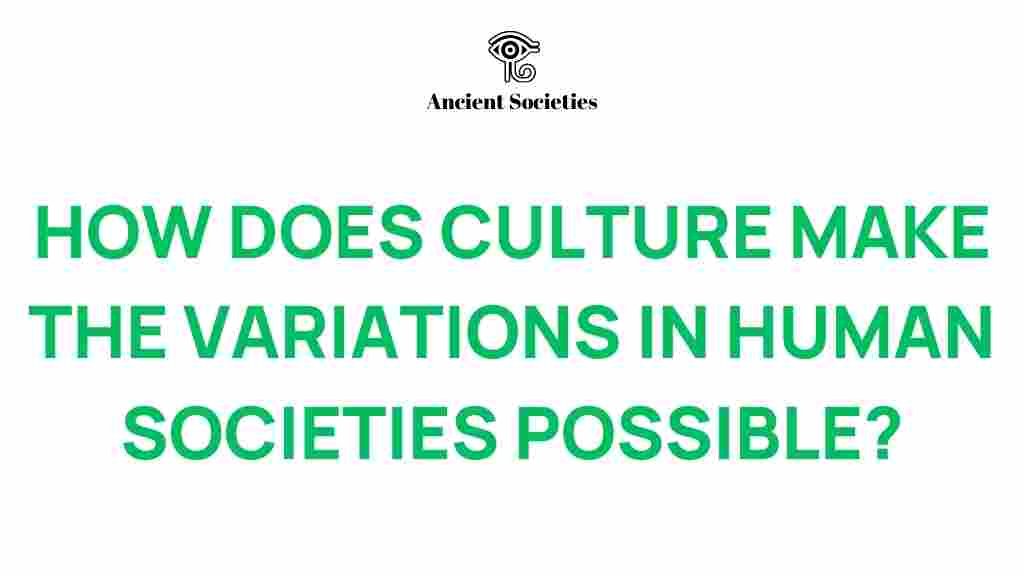The Intricate Dance of Culture: Shaping Human Societal Variations
Culture is one of the most fundamental aspects of human societies, influencing our behaviors, beliefs, and identities. It is a complex and dynamic system that encompasses the traditions, values, and norms that define a particular group. The interplay of culture and social dynamics is essential in understanding how societies evolve over time. In this article, we will explore the intricate dance of culture and its role in shaping human societal variations, emphasizing the importance of cultural diversity and its impact on our collective identity.
Understanding Culture and Human Societies
At its core, culture is the shared knowledge, practices, and beliefs that characterize a group. It is transmitted through generations and adapts to changing environments, reflecting the unique experiences and histories of different human societies. Here are some key components of culture:
- Traditions: These are the customs and practices passed down through generations, often celebrated during specific events or rituals.
- Values: The core principles and ideals that guide behavior and decision-making within a society.
- Identity: How individuals and groups perceive themselves and are perceived by others, often shaped by cultural context.
- Social Dynamics: The patterns of interaction and relationships within and between groups that influence cultural expression.
The Role of Anthropology in Cultural Understanding
Anthropology is the study of human societies, cultures, and their development. It provides valuable insights into the ways culture shapes human behavior and societal structure. By examining different cultures, anthropologists can identify commonalities and differences, helping us appreciate the rich tapestry of cultural diversity that exists worldwide.
Societal Evolution Through Cultural Diversity
Throughout history, human societies have evolved, influenced by various factors, including geography, technology, and intercultural interactions. Cultural diversity plays a significant role in this evolution:
- Adaptation: Societies adapt their cultural practices in response to environmental changes, ensuring survival and continuity.
- Innovation: Exposure to diverse cultures can lead to the exchange of ideas and practices, fostering creativity and innovation.
- Conflict and Cooperation: Different cultural perspectives can lead to both conflict and collaboration, shaping societal dynamics.
Traditions and Their Impact on Identity
Traditions are a vital part of cultural identity. They provide a sense of belonging and continuity, linking individuals to their community and ancestors. Here are some ways traditions impact identity:
- Community Cohesion: Shared traditions promote unity within a group, strengthening social bonds.
- Personal Identity: Individuals often find meaning and purpose through participation in cultural traditions.
- Preservation of Heritage: Traditions help preserve the history and values of a culture, passing them down to future generations.
The Dynamics of Values in Societal Interactions
Values are fundamental to understanding social dynamics within human societies. They shape attitudes, behaviors, and interactions among individuals and groups. Some key aspects include:
- Norms and Expectations: Values set the standards for acceptable behavior, guiding how individuals interact with one another.
- Cultural Change: As societies evolve, so do their values, reflecting shifts in priorities and beliefs.
- Social Justice: Understanding values can help address issues of inequality and promote social justice within diverse communities.
Step-by-Step Process: Embracing Cultural Diversity
To foster a deeper appreciation for cultural diversity within societies, consider the following step-by-step process:
- Education: Educate yourself and others about different cultures, their histories, and contributions.
- Engagement: Engage in cultural events and activities to experience different traditions and values firsthand.
- Dialogue: Create spaces for open dialogue about cultural differences and similarities to promote understanding.
- Advocacy: Advocate for policies that support cultural diversity and protect the rights of minority groups.
- Reflection: Reflect on your own cultural identity and values, considering how they shape your interactions with others.
Troubleshooting Tips for Cultural Misunderstandings
Despite our best efforts, cultural misunderstandings can still occur. Here are some troubleshooting tips to navigate these situations:
- Stay Calm: Approach misunderstandings with a calm demeanor to prevent escalating tensions.
- Listen Actively: Give the other person your full attention and listen to their perspective without interrupting.
- Ask Questions: Seek clarification if something is unclear, showing genuine interest in understanding their viewpoint.
- Apologize if Necessary: Acknowledge any offense caused and offer a sincere apology to mend relationships.
- Learn from the Experience: Use misunderstandings as learning opportunities to enhance your cultural competency.
Conclusion: The Continuous Dance of Culture
The intricate dance of culture is a powerful force in shaping human societies. As we navigate the complexities of cultural diversity, it is essential to recognize the values, traditions, and identities that define us. By embracing this diversity, we foster understanding and cooperation among different cultures, enabling societies to evolve in a harmonious manner.
In a world that is increasingly interconnected, the ability to appreciate and respect cultural differences is vital. Through education, engagement, and open dialogue, we can create inclusive communities that celebrate cultural diversity and contribute to the richness of human experience. For more information on cultural anthropology, you can visit this resource.
As we reflect on our own cultural identities, let us strive to understand and value the intricate dance of culture that shapes our lives and the world around us.
This article is in the category Culture and created by AncientSocieties Team

2 thoughts on “The Intricate Dance of Culture: Shaping Human Societal Variations”